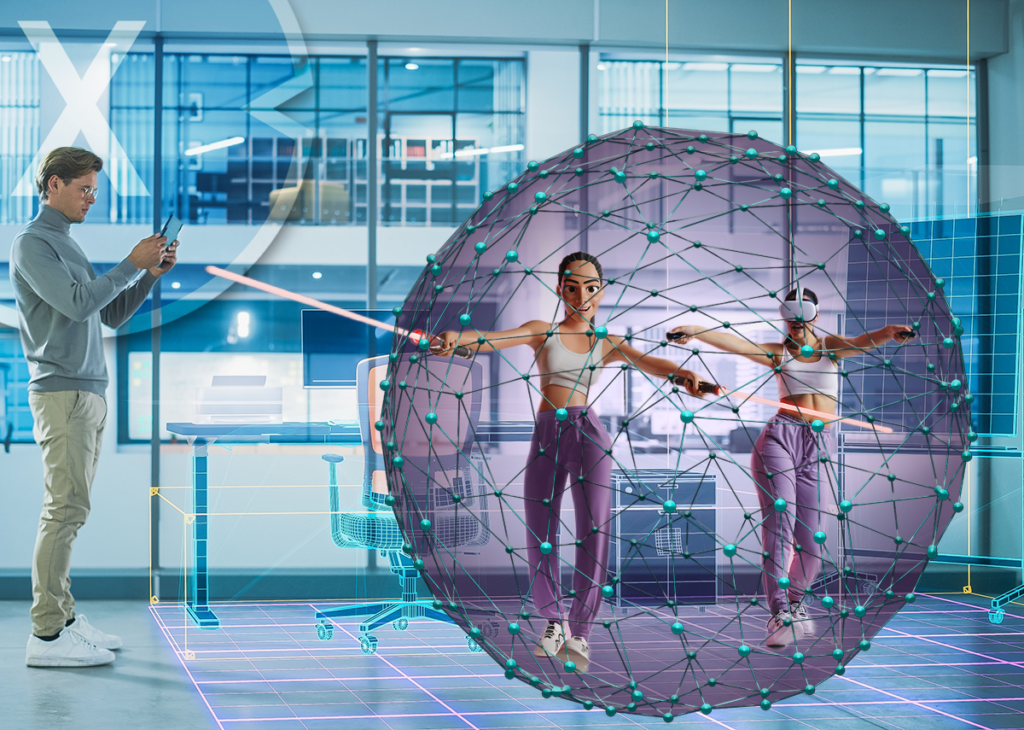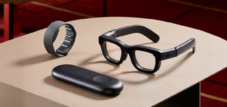Sharp Xrostella VR1: A VR revolution for glasses wearers? Sharp's new glasses with diopter adjustment up to -9.0
Xpert pre-release
Language selection 📢
Published on: November 16, 2025 / Updated on: November 16, 2025 – Author: Konrad Wolfenstein

Sharp Xrostella VR1: A VR revolution for glasses wearers? Sharp's new glasses with diopter adjustment up to -9.0 – Image source: Sharp / Creative image: Xpert.Digital
PC VR and mobile cinema in one: Sharp presents the versatile Xrostella VR1
New attack on Meta & Co.: What Sharp's comeback glasses Xrostella VR1 can really do
Japanese technology giant Sharp is making a triumphant return to the VR market with the Xrostella VR1, a remarkably lightweight and compact VR headset. Weighing in at just 198 grams, it positions itself as one of the most comfortable headsets for PC VR applications and mobile use. Its main focus, however, lies in a particularly convenient feature: an integrated diopter adjustment that allows users with nearsightedness up to -9.0 diopters to experience virtual reality without additional glasses or expensive lenses. Technically, the Xrostella VR1 utilizes high-resolution LCD displays with 2,160 x 2,160 pixels per eye, a 90 Hz refresh rate, and modern pancake lenses for a clear image. Featuring inside-out tracking with six degrees of freedom, the device is compatible with both PCs and – initially with some limitations – smartphones, where it functions as a high-quality video headset. Sharp plans to launch the product via a crowdfunding campaign on the Green Funding platform, which is scheduled to start in Japan at the end of November 2025, deliberately relying on community feedback and high media attention.
Suitable for:
- From AR to AI - everything that doesn't already exist: intelligent glasses, smart glasses, AI glasses, AR glasses, VR glasses, MR glasses and XR glasses
What is the Sharp Xrostella VR1?
The Sharp Xrostella VR1 is a new compact VR headset developed by the Japanese technology company Sharp. It's a wired headset designed for use with computers and smartphones. Weighing just 198 grams, the Xrostella VR1 is one of the lightest VR headsets on the market. The device is to be co-financed through the Green Funding platform in Japan, with the crowdfunding campaign scheduled to launch at the end of November 2025. Following the campaign launch, the Xrostella VR1 will initially be released in Japan, with availability in other markets still to be determined.
Why is Sharp using a crowdfunding model for these VR glasses?
Sharp's chosen crowdfunding approach for the Xrostella VR1 is likely driven primarily by marketing considerations. Through a campaign on the green-funding platform, the company aims to raise awareness of the device and generate buzz in the Japanese market. Crowdfunding also offers the opportunity to gather early feedback from potential customers and spark interest in a new and innovative product. This is particularly beneficial for a niche product like a specialized VR headset with diopter adjustment, as it targets a specific audience.
How does the Xrostella VR1 compare to the HTC Vive Flow?
The Sharp Xrostella VR1 is very similar in design and weight to the HTC Vive Flow, which HTC launched in 2021. The Vive Flow also weighs only 189 grams and was primarily designed for mobile viewing of 360-degree videos. Both devices are portable and designed for use on the go. The Vive Flow was also compatible with smartphones, offering similar functionality. However, the main difference lies in the technical specifications and available compatibility: While the Vive Flow offered an LCD display with a resolution of 1600 x 1600 pixels per eye, the Xrostella VR1 boasts superior specifications. Furthermore, both devices offer diopter adjustment, making them particularly appealing to eyeglass wearers.
Is the Xrostella VR1 also compatible with smartphones?
The Xrostella VR1 is compatible with smartphones and designed for mobile use. However, at launch, only Sharp's own smartphone model, the AQUOS sense10, is officially confirmed as compatible. The company has announced that more models will follow in the future. Smartphone compatibility differs from PC use in one important aspect: In mobile mode, the Xrostella VR1 functions as a video headset and is therefore more similar to display headsets from manufacturers like Viture and Xreal. For mobile applications, more intensive VR games are not possible; instead, the device is primarily used for watching videos and streaming content.
What PC requirements are needed to use the Xrostella VR1?
The following minimum requirements are necessary for using the Xrostella VR1 on a PC: an NVIDIA GeForce GTX 970 or comparable graphics card, an Intel Core i5-12600K or comparable processor, and at least 8 gigabytes of RAM. These requirements correspond to the standard minimum PC VR specifications that have been in place since the advent of VR headsets such as the HTC Vive and the Oculus Rift. The GeForce GTX 970 is a standard reference point that has been used for years as the minimum benchmark for VR-ready PC systems. With these specifications, a user should be able to run VR content with an appropriate frame rate and quality.
How does the inside-out tracking of the Xrostella VR1 work?
The Xrostella VR1 utilizes an inside-out tracking system based on two cameras, enabling six degrees of freedom of headset movement. Inside-out tracking means that cameras are integrated directly into the headset and observe the environment to determine the device's position and orientation. Visual features in the physical environment are analyzed to triangulate the headset's position. These cameras combine the image data with IMU data to obtain a precise position estimate. This allows the user to move around the virtual environment and perform six degrees of freedom of head movements: forward and backward, lateral movement, and rotation. In addition, the Xrostella VR1 features a supplementary color camera for viewthrough video, allowing the user to orient themselves in the physical space without removing the headset.
What are the technical specifications of the Xrostella VR1 display?
The Xrostella VR1 is equipped with two LCD displays offering a resolution of 2,160 x 2,160 pixels per eye. The refresh rate is up to 90 Hz. These specifications make it a high-resolution option in the lightweight VR headset segment. The pancake lenses are designed to provide a clear image with a 90-degree field of view. For comparison, the Meta Quest 3 has a resolution of 2,064 x 2,208 pixels per eye but a wider field of view. However, more expensive devices in higher price segments, such as the Apple Vision Pro and the Samsung Galaxy XR, achieve significantly higher resolutions of 3,648 x 3,144 and 3,552 x 3,840 pixels per eye, respectively. The Xrostella VR1 therefore positions itself in the mid-to-upper range of resolutions but remains below the top-tier models.
What are pancake lentils and how do they work?
Pancake lenses are a modern lens type that has become particularly prevalent in compact VR headsets. They utilize multiple mirrors and polarizing filters to fold the light path, enabling a flatter and more compact design. The principle works by folding several lenses together in a curve, with the light being reflected within the glass or plastic. This significantly reduces the distance between the wearer's eyes and the display. Pancake lenses provide high image sharpness right to the edges and minimize distortion and color fringing, also known as chromatic aberration. The result is a generous sweet spot and good wearing comfort. The Meta Quest 3 and the Pico 4 Ultra also employ this principle.
However, pancake lenses also have their drawbacks. The price for the flat design is high: every additional optical surface absorbs light. While aspherical glass lenses transmit up to 99 percent of the display light, pancake systems often only achieve around 15 percent. The result is lower brightness, reduced contrast, and less vibrant color reproduction, especially at the edges of the field of view. Despite these disadvantages, the advantages of pancake lenses currently outweigh the disadvantages, particularly when it comes to compact and lightweight form factors. According to scientific findings, pancake lenses should counteract myopics even with continuous use, making them particularly attractive for extended periods of wear.
What is the diopter control and why is it important for people who wear glasses?
The diopter adjustment is one of the Xrostella VR1's most outstanding features and something that eyeglass wearers will likely wish were standard on all VR headsets. A diopter is the unit of measurement used for visual acuity. Since wearing regular glasses with most VR headsets isn't practical, a diopter adjustment allows the optics to be adapted to the wearer's specific vision. The Xrostella VR1 offers a diopter adjustment that can be individually set, covering a range from 0 diopters to -9.0 diopters. This allows nearsighted users to use VR headsets without the need for corrective lenses or special prescription contact lenses.
This is a significant improvement in comfort for the millions of nearsighted VR users worldwide. Previously, they either had to purchase specially made prescription lenses, which is expensive, or wear their regular glasses under the VR headset, which is uncomfortable. The alternative was contact lenses, but these are not an option for everyone. By comparison, the HTC Vive Flow offers a similar diopter adjustment, but only in the range of 0 to -6 diopters, which provides less flexibility for those with higher levels of nearsightedness. The Xrostella VR1, with its range up to -9.0 diopters, is therefore more generously equipped.
How do the Xrostella VR1 controllers compare to modern VR controllers?
The Xrostella VR1's included controllers are striking and strongly reminiscent of the outdated MetaQuest 2 design. They feature bulky tracking rings, a design long since superseded by current VR devices. Modern devices almost universally use controllers without these cumbersome tracking rings, resulting in a sleeker and more comfortable feel. This is one of the weaknesses of the otherwise innovative Xrostella VR1 design.
However, it's only fair to say that the design choice likely had practical reasons. Two dedicated tracking cameras with a limited field of view might not work as reliably with modern ring-shaped controllers as systems with more cameras or base stations. This could be a deliberate engineering decision to ensure tracking reliability. On the other hand, the Xrostella VR1 doesn't offer hand tracking, a feature increasingly implemented in modern devices. This is also a limitation compared to newer flagship models.
🗒️ Xpert.Digital: A pioneer in the field of extended and augmented reality
Mobile cinema effect with the Xrostella VR1: VR glasses for on the go
How should the front-heavy design of the Xrostella VR1 be assessed?
One potential problem with the Xrostella VR1 could be its front-heaviness despite its light weight. A weight of only 198 grams sounds excellent, but if this weight isn't optimally distributed, it can still lead to discomfort, especially during extended use. This is a known issue with lightweight VR headsets that aren't perfectly balanced. The center of gravity shifts forward, which can cause neck strain.
It's therefore hardly surprising that pictures of the headset with an additional headband are already circulating online, even though Sharp's official press release doesn't mention it. This accessory could improve weight distribution and optimize the overall wearing position. A good head mount and a balanced design are at least as important for wearing comfort as the total weight. Users should therefore carefully consider before purchasing whether the Xrostella VR1 is ergonomically suited to their head or whether additional accessories are necessary.
Suitable for:
- Face to face with the present future: How augmented reality and AI will transform the global technology market
How does the Xrostella VR1 position itself in the market segment of compact PC VR headsets?
The question of whether the Xrostella VR1 can successfully hold its own in the lightweight PC VR headset segment is certainly valid. The competition in this segment is technically more powerful, but also significantly more expensive. The Bigscreen Beyond 2, for example, weighs only 107 grams, making it even lighter than the Xrostella VR1, yet it offers a resolution of 2,560 × 2,560 pixels per eye with micro-OLED displays. The Pimax Dream Air SE, announced for the end of 2025, weighs less than 150 grams and also features micro-OLED displays with 2,560 × 2,560 pixels per eye, combined with Tobii eye tracking and hand tracking. Both of these competing products are priced considerably higher than the expected price point of the Xrostella VR1.
In international comparison, Sharp also has to contend with the technically more advanced and also PC-compatible Meta Quest 3. The Quest 3 is a standalone headset that isn't tied to a PC but can also be used with one. At a price of just under €550 for the base version, it's cheaper than many dedicated PC VR headsets. The Xrostella VR1 will have to take this selling point into account.
What advantages might the Xrostella VR1 have over the competition?
Despite the competition, the Xrostella VR1 certainly has some strengths. Its light weight of 198 grams is a major plus and impressive among higher-end PC VR headsets. The integrated diopter adjustment system is a truly unique feature and appeals to a broad target audience. The 2160 x 2160 pixel LCD displays per eye offer a solid resolution that is sufficient for most applications. The inside-out tracking technology with two cameras is practical because it doesn't rely on external base stations.
The selling point of reduced ergonomics due to the low weight, however, needs to prove itself in practice. While the Bigscreen Beyond 2, for example, is even lighter at 107 grams, the Xrostella VR1 is still significantly lighter than most other VR headsets on the market, including the Meta Quest 3 at 515 grams.
Suitable for:
- Bigscreen Beyond 2-The smallest VR headset, the most compact and lightest VR glasses-a pioneer in the high-end PC-VR market
How does the resolution of the Xrostella VR1 compare to other premium VR devices?
The Xrostella VR1's resolution of 2,160 × 2,160 pixels per eye places it in the middle of the current market. The Meta Quest 3 offers a similar resolution of 2,064 × 2,208 pixels per eye, but is significantly heavier at 515 grams. The Samsung Galaxy XR achieves 3,552 × 3,840 pixels per eye, which is considerably sharper, but also costs significantly more. The Apple Vision Pro, with 3,648 × 3,144 pixels per eye, also offers a significantly higher resolution, but is considerably more expensive and heavier. In the price segment below premium flagship models, the Xrostella VR1's resolution is quite competitive.
What display technologies are used in modern VR headsets?
Modern VR headsets utilize various display technologies. The Xrostella VR1 uses LCDs, or liquid crystal displays. The Meta Quest 3 also employs LCDs with an RGB color space. Higher-end devices like the Bigscreen Beyond 2, the Pimax Dream Air, and the Samsung Galaxy XR, however, utilize micro-OLED displays, which offer higher contrast and brightness but are also more expensive to manufacture. The Apple Vision Pro, on the other hand, employs a micro-OLED display with special pancake lenses for enhanced brightness and contrast.
LCDs are less expensive to manufacture than micro-OLED displays, but offer slightly lower contrast and brightness. However, this isn't a major issue for most VR applications. The advantages of LCDs lie in their lifespan and reliability.
What is the expected price positioning of the Xrostella VR1?
Sharp has yet to announce the price, but it's likely to be above the roughly €550 Meta charges for a Quest 3. Since the Xrostella VR1 is a specialized PC VR headset with diopter adjustment and high-quality LCD displays, it will probably cost between €700 and €1000, or possibly even more. For comparison, the Bigscreen Beyond 2 is a specialized PC VR headset and costs considerably more. The exact pricing will be crucial for the Xrostella VR1's market success.
What exactly is the smartphone compatibility of the Xrostella VR1?
While the Xrostella VR1 is initially only compatible with Sharp's own AQUOS sense10, Sharp has announced that compatibility with other smartphone models will follow in the future. Mobile compatibility works differently than PC use. In mobile mode, the Xrostella VR1 functions as a video headset, similar to the Viture Pro XR and Xreal One display headsets. This means the smartphone serves as the content source, and its display is magnified through the VR headset's lenses. However, VR games are not an option in mobile mode, as a smartphone's processing power is insufficient, and the headset's inside-out tracking system may not be fully utilized in this mode.
For mobile use, the Xrostella VR1 is therefore primarily suitable for watching videos and streaming content. This makes it a portable cinema device that could be particularly interesting for travel and on the go.
What role do the tracking cameras and the color camera of the Xrostella VR1 play?
The Xrostella VR1 features two cameras for inside-out tracking and an additional color camera. The two tracking cameras enable the inside-out tracking system, which is responsible for tracking head position and movement. These cameras capture visual features in the environment, allowing for precise positioning in six degrees of freedom. The color camera, on the other hand, is responsible for video passthrough. This allows the user to see the physical world without removing the headset. This is particularly important for the user's safety and orientation in the physical environment.
How does the Xrostella VR1 compare to display glasses from Viture and Xreal?
The Xrostella VR1 differs from display-only headsets like the Viture Pro XR and the Xreal One in several key aspects. Viture and Xreal's display headsets are primarily designed for displaying magnified screens and do not offer full 6DoF tracking. In contrast, the Xrostella VR1 features a complete inside-out tracking system with two cameras, enabling 6DoF motion tracking. This makes the Xrostella VR1 a fully-fledged VR headset, not just a display headset.
On the other hand, Viture and Xreal display glasses offer optimized displays for video playback with high brightness and large virtual screens. The Viture Pro XR, for example, features a 135-inch virtual screen with up to 4000 nits of brightness and diopter adjustment down to -5.0. This makes it ideal for productivity and video streaming on the go. The Xrostella VR1, however, is a more versatile solution suitable for both VR and video streaming.
What are the future prospects for the Xrostella VR1?
The future prospects for the Xrostella VR1 are quite positive, provided the device is positioned at the right price and its technical execution meets expectations. The market for specialized PC VR headsets is growing, and the demand for lightweight and portable solutions is high. The diopter adjustment is a major plus that sets the Xrostella VR1 apart from many competitors. If Sharp provides the device with ongoing software support and expanded smartphone compatibility, it could become an attractive option for users seeking a balance between price, weight, and functionality.
The biggest challenges will likely be the strong presence of established manufacturers like Meta and HTC, and the formidable technical competition in the high-end segment. Sharp will need aggressive marketing and widespread availability to succeed in the global market. Limiting the launch to Japan could prove to be a strategic mistake if the device isn't introduced to other markets in a timely manner.
How could the Xrostella VR1 be further developed?
Future versions of the Xrostella VR1 could be improved in several areas. A hand-tracking system would enhance user interaction and make the VR experience more authentic. Modernized controllers without the bulky tracking rings would improve the overall feel of the device. Increasing the resolution to micro-OLED displays would significantly improve image quality but would also increase weight and price. Expanded smartphone compatibility with top models from all manufacturers would make mobile use more appealing. Furthermore, extending the diopter range for farsighted users could make the product more universal, although this would likely be technically challenging.
What requirements must a user meet to be able to use the Xrostella VR1 optimally?
To get the most out of the Xrostella VR1, users should meet or consider the following requirements. For PC use, a VR-ready PC with an Intel Core i5-12600K or better, an NVIDIA GeForce GTX 970 or similarly powerful graphics card, and at least 8 gigabytes of RAM is required. A stable USB cable is necessary, as the Xrostella VR1 is wired. For mobile use, a compatible smartphone is required; at launch, only the AQUOS sense10 is supported.
The user should realistically assess whether the front-heavy design is comfortable for them, or whether additional accessories such as a headband will be necessary. The interpupillary distance should fall within the supported range to ensure the glasses fit correctly. People with myopia up to -9.0 diopters can benefit from the diopter adjustment, while those with other vision impairments may require different solutions.
Your global marketing and business development partner
☑️ Our business language is English or German
☑️ NEW: Correspondence in your national language!
I would be happy to serve you and my team as a personal advisor.
You can contact me by filling out the contact form or simply call me on +49 89 89 674 804 (Munich) . My email address is: wolfenstein ∂ xpert.digital
I'm looking forward to our joint project.
☑️ SME support in strategy, consulting, planning and implementation
☑️ Creation or realignment of the digital strategy and digitalization
☑️ Expansion and optimization of international sales processes
☑️ Global & Digital B2B trading platforms
☑️ Pioneer Business Development / Marketing / PR / Trade Fairs
🎯🎯🎯 Benefit from Xpert.Digital's extensive, five-fold expertise in a comprehensive service package | BD, R&D, XR, PR & Digital Visibility Optimization

Benefit from Xpert.Digital's extensive, fivefold expertise in a comprehensive service package | R&D, XR, PR & Digital Visibility Optimization - Image: Xpert.Digital
Xpert.Digital has in-depth knowledge of various industries. This allows us to develop tailor-made strategies that are tailored precisely to the requirements and challenges of your specific market segment. By continually analyzing market trends and following industry developments, we can act with foresight and offer innovative solutions. Through the combination of experience and knowledge, we generate added value and give our customers a decisive competitive advantage.
More about it here:
























